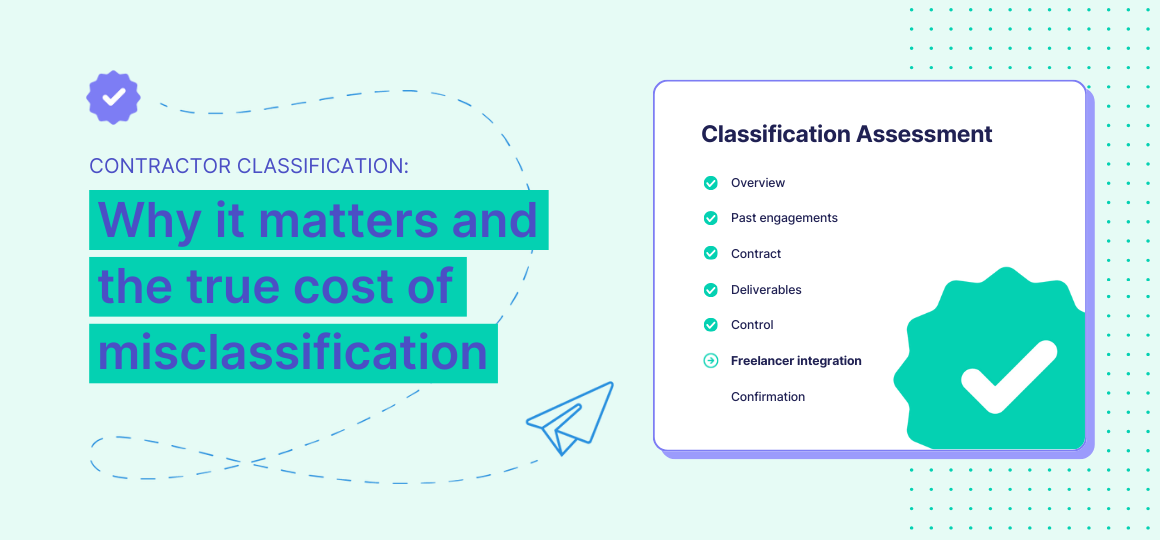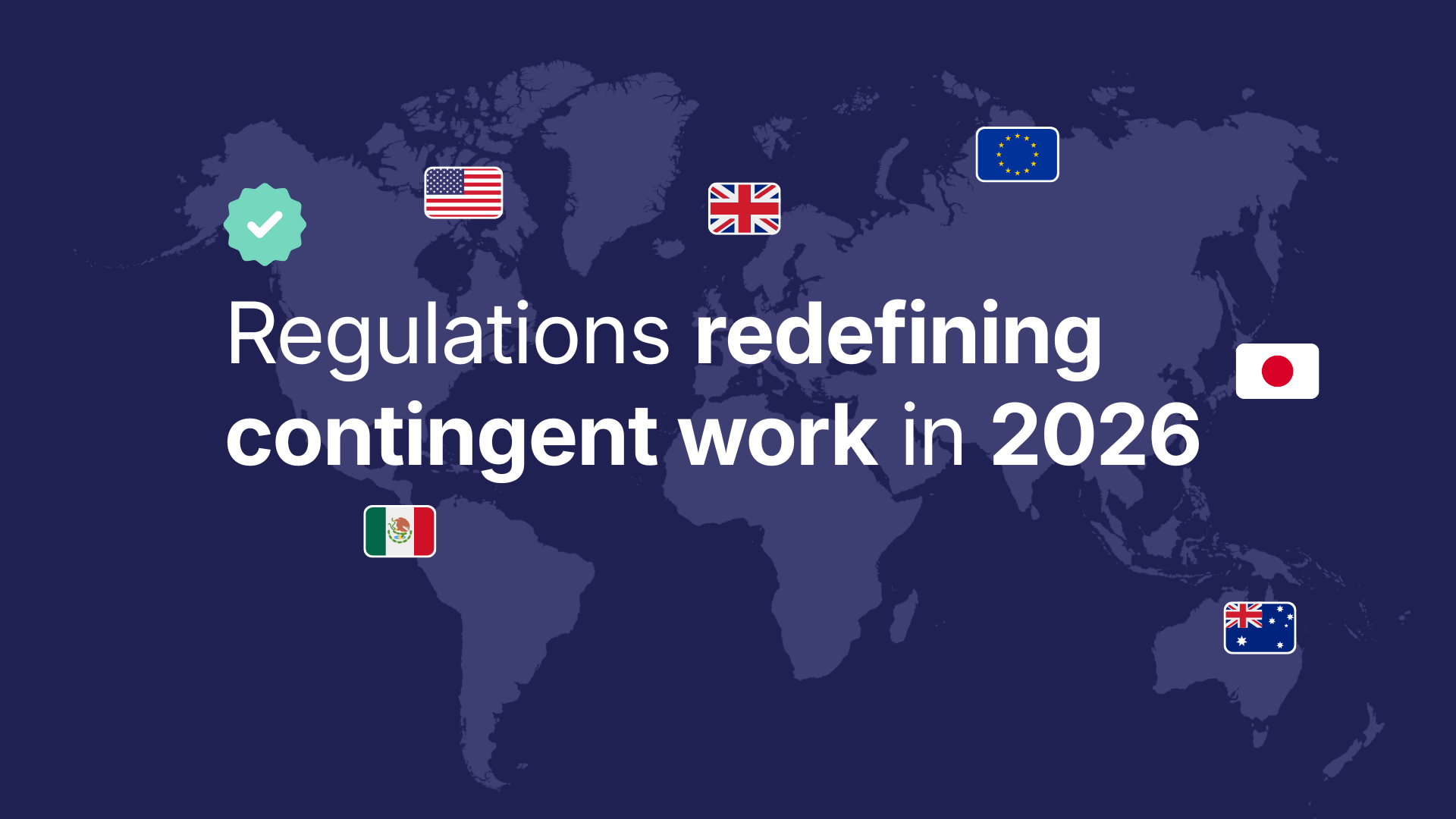The gig economy has become an integral part of how companies operate and with the rise of remote work and flexible employment arrangements, more businesses are turning to contractors and freelancers to meet their staffing needs. However, this shift brings with it a critical consideration: contractor classification. Understanding the importance of proper classification and the potential consequences of misclassification is crucial for businesses of all sizes.
What is contractor classification?
Contractor classification refers to the process of determining whether a worker should be categorised as an employee or an independent contractor. This distinction is not merely a matter of semantics; it has significant legal, financial, and operational implications for both the business and the worker.
The classification process involves evaluating various factors, including:
- The level of control the company has over the worker's tasks and schedule
- The worker's level of economic independence
- The duration and permanency of the working relationship
- The worker's level of skill and expertise
- Whether the work is integral to the company's core business
Why contractor classification matters
Proper contractor classification is crucial for several reasons:
Legal compliance
Different countries and jurisdictions have specific laws and regulations governing employment relationships. Misclassifying workers can lead to legal troubles and hefty fines. For instance, in the UK, HM Revenue & Customs (HMRC) has strict guidelines on employment status, and failure to adhere to these can result in significant penalties.
Tax implications
The classification of a worker directly impacts tax obligations for both the company and the individual. Employees typically have taxes withheld from their paychecks, while independent contractors are responsible for their own tax payments. Misclassification can lead to underpayment or overpayment of taxes, creating financial and administrative headaches.
Benefits and protections
Employees are entitled to various benefits and protections under labour laws, such as minimum wage, overtime pay, paid leave, and workplace safety regulations. Independent contractors, on the other hand, are generally not entitled to these benefits. Misclassification can deprive workers of their rightful benefits or unnecessarily burden companies with benefit provisions.
Business operations
The way a company manages its workforce differs significantly between employees and contractors. Misclassification can lead to inefficiencies in workforce management, project planning, and resource allocation.
.png)
The true cost of misclassification
Misclassifying workers can have severe consequences for businesses. The true cost extends far beyond mere financial penalties and can impact various aspects of a company's operations and reputation.
Financial penalties
The most immediate and tangible cost of misclassification comes in the form of financial penalties imposed by regulatory bodies. These can be substantial, often amounting to significant percentages of the misclassified wages. For example, in a historic legal resolution, rideshare company Uber Technologies and Lyft Inc. have agreed to a $175 million settlement with the state of Massachusetts. This landmark agreement addresses the ongoing issue of misclassifying drivers as independent contractors instead of employees and could have profound implications for contractor compliance across the industry.
Legal costs
Misclassification can lead to lawsuits from workers claiming they were denied rightful benefits and protections. Defending against such lawsuits can be costly, both in terms of legal fees and potential settlements. Moreover, class-action lawsuits involving multiple misclassified workers can result in even more significant financial exposure.
Reputational damage
News of worker misclassification can spread quickly, potentially damaging a company's reputation. This can lead to loss of customer trust, difficulty in attracting top talent, and strained relationships with partners and stakeholders.
Operational disruptions
Addressing misclassification issues often requires significant time and resources, diverting attention from core business activities. This can lead to operational inefficiencies and missed opportunities.
Backdated benefits and wages
If workers are found to have been misclassified, companies may be required to provide backdated benefits and wages. This can include overtime pay, holiday pay, pension contributions, and other employee benefits that were not initially provided.
Tax liabilities
Misclassification often results in underpayment of employment taxes. When discovered, companies may be required to pay these taxes retroactively, often with interest and penalties. This can create unexpected financial burdens and impact cash flow.
Preventing misclassification: Best practices
Given the significant risks associated with misclassification, it's crucial for businesses to implement best practices to ensure proper contractor classification:
Conduct regular audits
Regularly review your workforce to ensure that all workers are correctly classified. This should include an assessment of job duties, level of control, and other relevant factors.
Develop clear policies
Establish clear, written policies regarding the classification of workers. These policies should be consistently applied across the organisation.
Provide training
Ensure that managers and HR personnel are trained on the criteria for proper classification and the importance of adhering to these guidelines.
Seek expert advice
Employment laws can be complex and vary by jurisdiction. Consider consulting with legal experts or using specialised services to ensure compliance. At YunoJuno, we offer built-in, instant global worker classification to help businesses navigate these complexities with confidence.
Use written agreements
Always use clear, written agreements that specify the nature of the working relationship, whether it's an employment contract or an independent contractor agreement.
Stay informed
Keep abreast of changes in employment laws and regulations that may affect worker classification in your jurisdiction.

The role of technology in contractor classification
As the workforce becomes increasingly global and diverse, technology is playing a crucial role in helping businesses manage contractor classification effectively. Advanced platforms can automate much of the classification process, reducing the risk of human error and ensuring consistency across the organisation.
For instance, YunoJuno's platform offers automated contracts, workflows, and data storage, streamlining the onboarding process for contractors. Our built-in global worker classification technology helps businesses remove risks and hire with confidence, providing misclassification indemnity and global insurance.
Conclusion
Contractor classification is a critical aspect of modern workforce management. The consequences of misclassification can be severe, ranging from financial penalties and legal troubles to reputational damage and operational disruptions. By understanding the importance of proper classification and implementing best practices, businesses can mitigate these risks and build a flexible, compliant workforce.
Leveraging technology and expert services can provide invaluable support in navigating the intricacies of contractor classification. By prioritising proper classification, businesses can not only avoid costly mistakes but also build stronger, more productive relationships with their workforce, setting the stage for sustainable growth and success.







